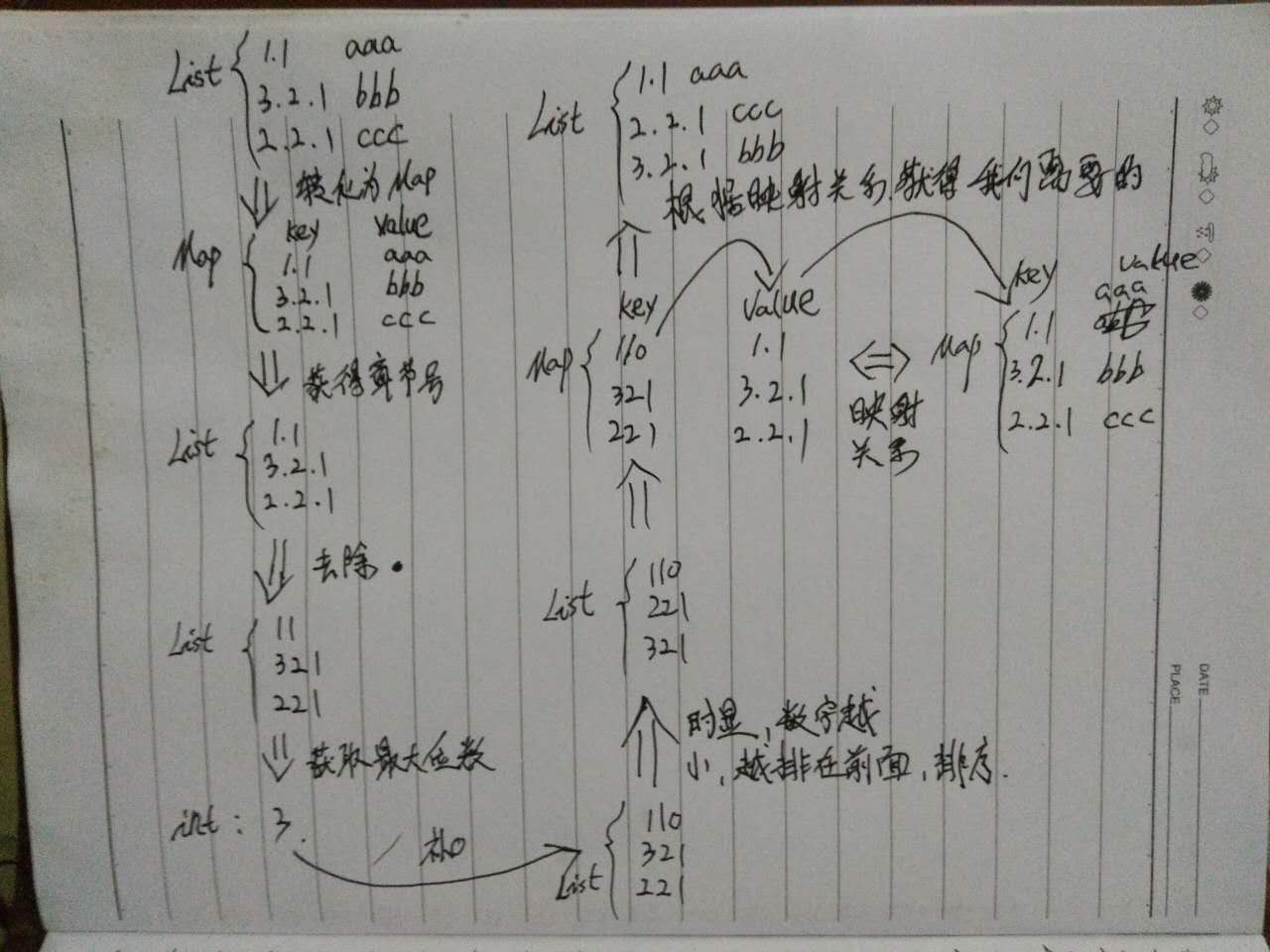
Poser une question
Comment trier les chapitres dans un vrai projet ? ? ?
Résoudre le problème
Ce qui suit est un problème de tri des chapitres dans un projet réel. J'espère que les programmeurs qui rencontreront ce problème à l'avenir pourront fournir une référence. J'espère que je viens de commencer à apprendre. Pour les étudiants en programmation, cela peut être utilisé comme exemple pour la pratique, etc. L'image est l'idée et le code est la mise en œuvre.

[code]package com.hwy.test;
import java.util.*;
/**
* 章节排序
* Created by Ay on 2016/7/9.
*/
public class ChapterSortTest {
public static void main(String[] args) {
/** 从数据库加载数据 **/
List<String> chapterList = getDataFromDB();
/** 章节list转化为map **/
Map<String,String> chapterMap = listChangeToMap(chapterList);
/** 获得章节号 **/
List<String> chapterNum = getChapterNum(chapterMap);
/** 章节号去除点 **/
Map<Integer,String> chapterNumNoDot = removeDot(chapterNum);
/** 获取数字最大长度 **/
int maxLength = getChapterNumMaxLength(chapterNumNoDot.keySet());
/** 获取补0后的列表 **/
List<String> fillZeroChapterNum = fillZero(maxLength,chapterNumNoDot);
/** 排序 默认是升序,刚好是我们需要的**/
Collections.sort(fillZeroChapterNum);
/** 重组map对象**/
List<String> sortChapterList = getSortChapterMap(fillZeroChapterNum,chapterMap,chapterNumNoDot);
/** 打印信息 **/
if(sortChapterList != null){
for(String key:sortChapterList){
System.out.println(key);
}
}
}
/**
* 获得排序后的map
* @param fillZeroChapterNum
* @param chapterMap
* @return
*/
public static List<String> getSortChapterMap(List<String> fillZeroChapterNum,Map<String,String> chapterMap,Map<Integer,String> chapterNotDot){
if(null == fillZeroChapterNum || fillZeroChapterNum.size() == 0) return null;
if(null == chapterMap) return null;
List<String> sortChapterList = new ArrayList<>();
for(String temp:fillZeroChapterNum){
sortChapterList.add(chapterNotDot.get(Integer.parseInt(temp.replace("0", ""))) + " " + chapterMap.get(chapterNotDot.get(Integer.parseInt(temp.replace("0", "")))));
}
return sortChapterList;
}
/**
* 补零操作
* @return
*/
public static List<String> fillZero(int maxLength,Map<Integer,String> chapterNumNoDot){
if(null == chapterNumNoDot || chapterNumNoDot.size() ==0) return null;
List<String> fillZeroList = new ArrayList<>();
for(Integer key:chapterNumNoDot.keySet()){
fillZeroList.add(key + getNeedZero(maxLength - (key + "").length()));
}
return fillZeroList;
}
/**
* 获得需要0的个数
* @param num
* @return
*/
public static String getNeedZero(int num){
if(num <1) return "";
StringBuffer sb = new StringBuffer();
/** 拼凑需要的0 **/
for(int i=0;i<num;i++){
sb.append("0");
}
return sb.toString();
}
/**
* 返回数组最大值
* @param a
* @return
*/
public static int max(int[] a){
// 返回数组最大值
int x;
int aa[]=new int[a.length];
System.arraycopy(a,0,aa,0,a.length);
x=aa[0];
for(int i=1;i<aa.length;i++){
if(aa[i]>x){
x=aa[i];
}
}
return x;
}
/**
* 获得章节号最大长度
* @param chapterNumNoDot
* @return
*/
public static int getChapterNumMaxLength(Set<Integer> chapterNumNoDot){
if(null == chapterNumNoDot || chapterNumNoDot.size() == 0) return 0;
Object[] chapterNumArr = chapterNumNoDot.toArray();
int[] chapterNum = new int[chapterNumArr.length];
for(int i=0;i<chapterNumArr.length;i++){
chapterNum[i] = chapterNumArr[i].toString().length();
}
return max(chapterNum);
}
/**
* 去除章节号中的点
* @param chapterNumList
* @return
*/
public static Map<Integer,String> removeDot(List<String> chapterNumList){
if(null == chapterNumList || chapterNumList.size() == 0) return null;
Map<Integer,String> rmDotChapterNumMap = new HashMap<>();
for(int i=0;i<chapterNumList.size();i++){
/** 把点替换成空 **/
rmDotChapterNumMap.put(Integer.parseInt(chapterNumList.get(i).replace(".","")),chapterNumList.get(i));
}
return rmDotChapterNumMap;
}
/**
* 获取章节号
* @param chapterMap
* @return
*/
public static List<String> getChapterNum(Map<String,String> chapterMap){
if(null == chapterMap) return null;
List<String> chapterNumList = new ArrayList<>();
for(String chapterNum:chapterMap.keySet()){
chapterNumList.add(chapterNum);
}
return chapterNumList;
}
/**
* 把list转变为map
* @param chapterList
* @return
*/
public static Map<String,String> listChangeToMap(List<String> chapterList){
/** 存到map中 **/
Map<String,String> chapterMap = new HashMap<>();
if(null == chapterList || chapterList.size() == 0) return null;
for(String chapter:chapterList){
chapterMap.put(chapter.split(" ")[0], chapter.split(" ")[1]);
}
return chapterMap;
}
/**
* 从数据库获取数据
* @return
*/
public static List<String> getDataFromDB(){
List<String> chapterList = new ArrayList<>();
chapterList.add("1.3.1 华丽新设计");
chapterList.add("1.4 思想流派");
chapterList.add("3.1 短小");
chapterList.add("3.2 只做一件事");
chapterList.add("2.11 别伴可爱");
chapterList.add("4.4.12 注释掉的代码");
chapterList.add("1.1 要有代码");
chapterList.add("2.1 介绍");
chapterList.add("8.5 使用尚不存在的代码");
chapterList.add("5.3.1 水平方向上的区隔与靠近");
return chapterList;
}
}Ce qui précède est le contenu d'exemples de tri de chapitres dans de vrais projets Java. Pour plus de contenu connexe, veuillez faire attention au site Web PHP chinois (www.php. cn) !